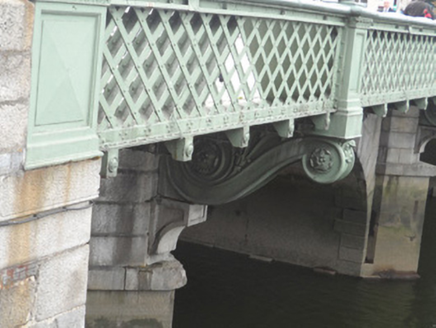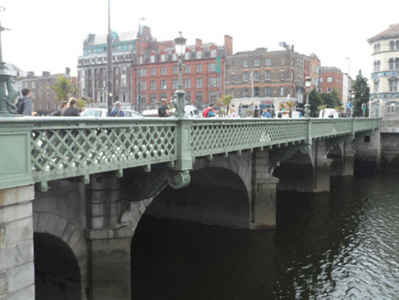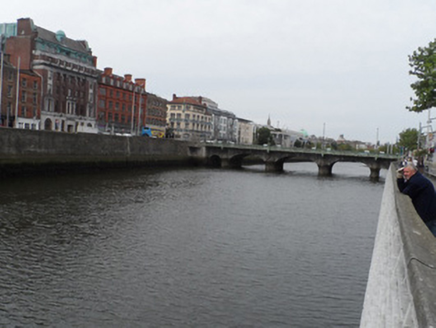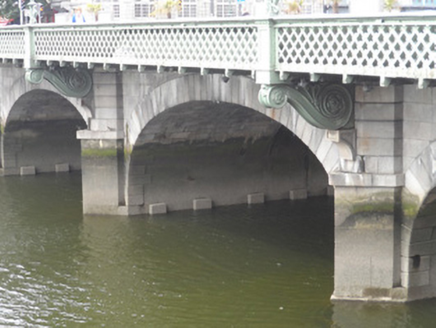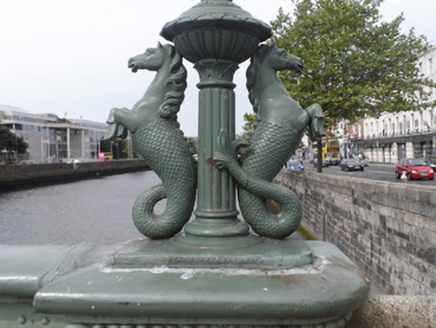Survey Data
Reg No
50060361
Rating
Regional
Categories of Special Interest
Architectural, Artistic, Technical
Previous Name
Essex Bridge
Original Use
Bridge
In Use As
Bridge
Date
1870 - 1875
Coordinates
315418, 234200
Date Recorded
01/09/2014
Date Updated
--/--/--
Description
Five-arch bridge over river, rebuilt 1873-4, reusing piers and pilings of earlier bridge of 1753-5. Granite ashlar walls with granite ashlar triangular cutwaters supporting rusticated granite ashlar triangular piers. Series of three elliptical arches between pair of round arches with rusticated granite ashlar voussoirs. Cantilevered deck including wrought iron girders supporting wrought iron lattice work parapets with hippocampus-detailed cast-iron lamp standards on panelled piers on rosette-detailed volute corbels on cut-granite panelled "Cavetto" corbels. Sited spanning River Liffey with granite ashlar retaining walls to river having "saddleback" coping.
Appraisal
Grattan Bridge, originally known as Essex Bridge, is one of several bridges over the River Liffey which help to define the character of this central artery as it winds its way to Dublin Port and the Irish Sea. The first bridge on the site was built (1676) by Humphrey Jervis (1630-1707) and was designed to connect the fashionable Capel Street on the north side of the city with Dublin Castle on the south side of the city. The narrow humpback bridge, prone to flooding and requiring constant repair, partially collapsed in 1751. The second bridge was designed by George Semple (c.1700-82) and, modelled after the Charles Labelye (1705-62)-designed Westminster Bridge (1739-50) in London, was built (1753-5) by Robert Mack at a cost of £20,661 11s. 4d.. The approach too steep, the deck too narrow, the bridge was rebuilt (1873-4) by William James Doherty (c.1834-98) to designs by Bindon Blood Stoney (1828-1909) of the Dublin Port and Docks Board with the designs calling for the retention and reuse of the piers and pilings of the Semple-designed bridge. The third bridge therefore married conventional and pioneering construction techniques with Classically-detailed arches of silver-grey granite giving way to a deck of engineered iron and utilitarian appearance: the effect was criticised in The Irish Builder (1st October 1874) whose correspondent condemned 'the footways – apparently an afterthought – supported upon the most primitive-looking and certainly the clumsiest attempts at corbelling ever beheld...no after decoration can by possibility remove [its] unsightly appearance. Ornament, certainly, seems to have been sacrificed to utility in this instance for which no amount of painting and gilding will compensate'. The cast-iron lamp standards with coupled hippocampi at the bases were installed at a later date and appear to have been produced by Kennan and Sons (established 1780) of nearby Fishamble Street; the pedestals carry the name of the Sirocco Foundries (established 1881) of Belfast. The bridge, originally named in honour of Arthur Capel (1631-83), first Earl of Essex and Lord Lieutenant of Ireland (appointed 1672), was renamed in honour of Henry Grattan (1746-1820) 'BY THE MUNICIPAL COUNCIL 1875'.
